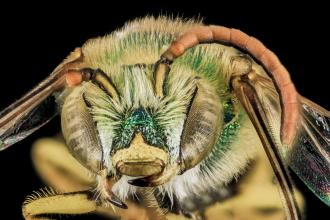
The Breadth of Bees...
Apiculture is the science of raising or maintaining colonies of bees and their hives (beekeeping). Known primarily for their pollinating activities, our nation’s 4,000+ native bee species also produce honey, wax, pollen, propolis, royal jelly, and even venom – all of which are collected and sold by farmers and beekeepers for their nutritional and medicinal purposes.
Bees in Agriculture
Archaeological evidence shows us that the relationship between humans and bees is at least 17,000 years old (Pager, 1976), with the earliest depictions of human honey hunting and harvesting of bee products occurring 4,000 years before our earliest systems of domesticated agriculture; but it wasn’t until nearly 14,000 years later that we find the first evidence of sophisticated bee colony management as part of an agricultural system (Bloch et al., 2010, PNAS).
With more than 4,000 native bees in North America, honey bees take much of the spotlight in agriculture - but they are not native to our country. They were imported from Europe in the 17th century.
Early USDA Beekeeping and Apiculture
The USDA began its research on bees in 1891 at the Bee Research Laboratory in Beltsville, Maryland. Now there are many USDA-related research facilities as well as other federal agencies supporting bees. (See Federal Bee Research Products below).
Interested in some basic information from the earlier years? Take a look at the documents below.
- Beekeeping. 1905. F. Benton (In charge of Apicultural Investigations). U.S. Department of Agriculture. Farmer’s Bulletin No. 59 (revised)
- The Rearing of Queen Bees. 1905. Phillips, E.F. (Expert Apiculturist). U.S. Department of Agriculture. Bureau of Entomology Bulletin No. 55
- Beekeeping in the United States. 1980. Martin, E. C, E. Oertel, N. P. Nye, et al. U.S. Department of Agriculture, Agriculture Handbook No. 335 (revised)
Discover digitized, historical materials in NAL's Internet Archive Collection [archive.org] using these queries:
SEARCH Dynamic Queries for Apiculture Content at the Library

The History of Honey Bee Culture
This NAL online exhibit highlights historical resources from the earliest published works on honeybee husbandry, including items from Thomas Hill (1572) and Charles Butler (1609).
Resources for Starting a Hive or Bee Colony
General Guidelines and Foundational Information
- Bee Basics: An Introduction to Our Native Bees (2011, USDA Forest Service) (PDF | 1,516 KB)
Native pollinators, particularly bees other than honey bees, have been pollinating the continent’s flowering plants since long before the arrival of the European honey bee - and continue to be the majority pollinator...especially when it comes to native plants.
- Beekeeping for Beginners (1974, USDA)
Designed for the new hive owner, this bulletin provides information on the basics to get you started including equipment, colony behavior, bee lines, and beehive designs.
- Good Beekeeping Practices for Sustainable Agriculture (2021, FAO)
An extensive guideline that covers beekeeping from ground-level definitions to full production processes. Catered to small-scale beekeepers.
- Instrumental Insemination of Queen Bees (1970, USDA Agricultural Research Service)
A manual introducing instrumental insemination of honey bees to beekeepers, scientists, and technical workers in apiculture.
Find Technical Services Near You
- USDA Programs and Resources to Support Beekeepers
Valuable summary of USDA insurance programs, disaster assistance programs, loan programs, and other resources for beekeepers.
- USDA Service Center Locations
Find your local USDA Service Center and access services provided by the Farm Service Agency, Natural Resources Conservation Service, and the Rural Development agencies.
- Local Extension Services [nifa.usda.gov]
Your local university extension service has expertise in your growing environment across species and crops of all kinds. They can offer evaluation services, inspection information, and help identifying pests, etc.
- Partner Organizations
The USDA has many partnerships with non-profit organizations that curate a variety of informational resources.
Federal Bee Research Products
Reports and Articles
-
2022 USDA Annual Strategic Pollinator Priorities Report (PDF | 1.82 MB)
This 2022 report outlines the coordinated efforts of the USDA and partner research priorities in five pollinator health subject-matter areas: status and trends; forage, habitat, and nutrition; environmental stressors; pests and pathogens; and genetics and biology.
-
Honey Bee Surveys and Reports (USDA National Agricultural Statistics Service)
NASS’s three annual surveys and reports (Honey, the Honey Bee Colonies, and the Cost of Pollination) provide information on hive and colony health, honey production, and economic impact.
-
Bee-related Research Articles
Use NAL's SEARCH to locate articles in the library's collection on apiculture research and issues that impact beekeepers.
Data Sets, Software, and Modeling Tools
-
Ag Data Commons
Access open data relevant to USDA-funded agricultural research on beekeeping or apiculture.
USDA Bee Research and Programs
- Agricultural Research Service (ARS)
- Animal Plant and Health Inspection Service
- The Climate Hubs
- Farm Service Agency (FSA)
- Forest Service (FS)
- Natural Resources Conservation Service (NRCS)
For a complete list of Federal and external partners, visit USDA Pollinators.
Prefer a Video?
Scientists strive to improve resilience to pathogens, parasites, poor nutrition, and pesticides in honey bee populations. The ARS Bee Lab in Baton Rouge, LA, has identified a genetic link to reduced colony defensiveness and predict this may improve relationships with the humans that manage them.
Scientists from Project Apis m. and the USDA discuss breeding of bees that are naturally resistant to the Varroa parasite. This pest causes huge losses in the bee industry and having natural resistances precludes the need for applied insecticides.
 An official website of the United States government.
An official website of the United States government.